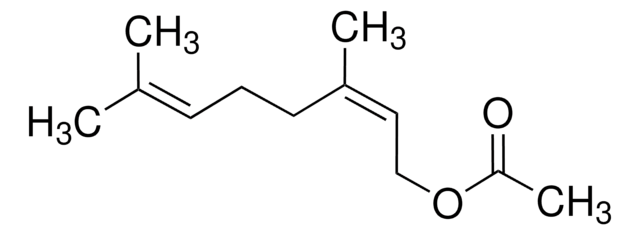W327506
Dimethyl trisulfide
≥98%, FG
Sinónimos:
2,3,4-trithiapentane, Methylsulfanyldisulfanylmethane
About This Item
Productos recomendados
biological source
synthetic
Quality Level
grade
FG
Halal
Kosher
agency
meets purity specifications of JECFA
reg. compliance
EU Regulation 1334/2008 & 178/2002
assay
≥98%
refractive index
n20/D 1.602 (lit.)
bp
58 °C/15 mmHg (lit.)
mp
−68 °C (lit.)
density
1.202 g/mL at 25 °C (lit.)
application(s)
flavors and fragrances
documentation
see Safety & Documentation for available documents
food allergen
no known allergens
organoleptic
meaty; alliaceous; sulfurous
SMILES string
CSSSC
InChI
1S/C2H6S3/c1-3-5-4-2/h1-2H3
InChI key
YWHLKYXPLRWGSE-UHFFFAOYSA-N
¿Está buscando productos similares? Visita Guía de comparación de productos
Categorías relacionadas
General description
Application
- Exploring the binding affinity and characteristics of DcitOBP9 in citrus psyllids.: This study investigates the binding properties of dimethyl trisulfide (DMTS) with DcitOBP9, an odorant-binding protein in citrus psyllids, providing insights into the potential role of DMTS in pest management strategies (Pei et al., 2024).
signalword
Warning
hcodes
Hazard Classifications
Acute Tox. 4 Oral - Eye Irrit. 2 - Flam. Liq. 3 - Skin Irrit. 2 - STOT SE 3
target_organs
Respiratory system
Storage Class
3 - Flammable liquids
wgk_germany
WGK 3
flash_point_f
132.8 °F - closed cup
flash_point_c
56 °C - closed cup
ppe
Eyeshields, Faceshields, Gloves, type ABEK (EN14387) respirator filter
Elija entre una de las versiones más recientes:
¿Ya tiene este producto?
Encuentre la documentación para los productos que ha comprado recientemente en la Biblioteca de documentos.
Los clientes también vieron
Nuestro equipo de científicos tiene experiencia en todas las áreas de investigación: Ciencias de la vida, Ciencia de los materiales, Síntesis química, Cromatografía, Analítica y muchas otras.
Póngase en contacto con el Servicio técnico












